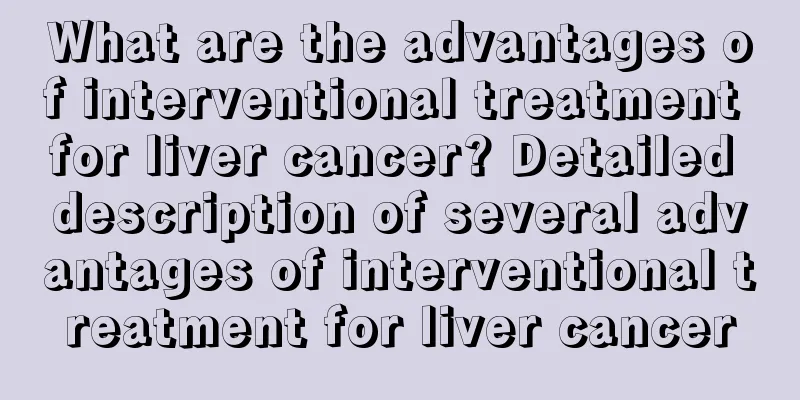What are the advantages of interventional treatment for liver cancer? Detailed description of several advantages of interventional treatment for liver cancer

|
Although the term "interventional diagnosis and treatment" is familiar to many people, many lack the most direct understanding and know very little about its true nature. According to experts, interventional radiology is an emerging clinical discipline that integrates the American Society of Medical Imaging and accumulated clinical treatment surgery. It uses minimally invasive methods under the guidance of medical imaging equipment to achieve the purpose of diagnosing or treating diseases. It has many advantages such as less trauma, less pain, quick results, fewer complications, quick recovery, and no damage to the body structure. One of the treatments for liver cancer is interventional therapy. Let the experts explain it to you below. Interventional treatment for liver cancer Chemotherapy is the application of chemical drugs for treatment. In the past half century, chemotherapy has developed from the single application of a few chemotherapy drugs to the combined application of multiple drugs. In addition to the original intravenous systemic chemotherapy, new methods of administration have also emerged, such as adjuvant chemotherapy, neoadjuvant chemotherapy, and special chemotherapy (arterial, intracavitary perfusion, etc.). Since chemotherapy drugs can cause damage to the patient's body while destroying cancer cells, it is currently not recommended to use systemic intravenous chemotherapy for liver cancer patients in clinical practice, but to use less harmful radiological interventional therapy. Radiological interventional therapy is a new chemotherapy approach developed in recent years. The method is to enter the hepatic artery that supplies blood to liver cancer through a catheter, inject chemotherapy drugs, increase local drug concentration and thus improve efficacy, while reducing the toxic side effects of chemotherapy drugs on other parts of the body. Radiological interventional therapy is mainly suitable for liver cancer patients whose conditions are not too bad but are not suitable for surgery. At present, this method has become the first choice for non-surgical treatment of patients with unresectable liver cancer. Its disadvantages are that it is not effective for secondary liver cancer and some primary liver cancers, and it can cause liver damage. What are the advantages of interventional treatment for liver cancer? Experts said that interventional treatment of primary liver cancer has many advantages, such as minimally invasive, fast recovery, and strong repeatability. It has become an important means of liver cancer treatment, especially for patients who cannot undergo surgical resection or are unwilling to undergo surgical treatment. And for patients with small liver cancer (tumor diameter less than 5cm, number less than 3), TACE combined with ablation treatment can also achieve a treatment effect comparable to surgery. |
Recommend
What kind of care should be paid attention to after cerebral hemorrhage surgery
Nowadays, more and more people suffer from diseas...
Is it okay if I took a sip of gasoline?
Is it okay to drink a sip of gasoline? Gasoline i...
Causes of little toe pain
You may not notice it when you are normally movin...
How to induce vomiting to lose weight?
For women who love beauty, obesity is not allowed...
Does jogging hurt your knees?
Jogging is a very good sport in today's life....
Why don't you like to talk
Everyone has different personality traits. Some p...
Don’t underestimate teeth grinding, what are its dangers?
Many people do not take teeth grinding seriously....
Does less frequent urination mean kidney problems?
The kidneys are closely related to a person's...
Benefits of drinking ginger and red dates soaked in water
Ginger has high medicinal value. It is spicy but ...
What should I do if I have cold body and weak spleen?
Cold body and spleen deficiency often occur in fe...
6 major clinical manifestations of benign brain tumors
Benign brain tumors refer to tumors with good tis...
Why is my right eye twitching? Beware of these reasons
Many people think that the right eye twitching is...
What are the taboos of the effects of snow clam?
Snow clam is a relatively common food. It is rich...
Will blood pressure rise after taking a bath
Blood pressure will not rise after taking a showe...
There are gray spots in the armpits. When it gets hot, it turns red. It doesn't hurt or itch. There is no reaction in winter.
Many people have gray spots under their armpits, ...









